Every electric guitar player knows that pickups are important, but there’s a lot more to pickups that a lot of guitarists don’t actually know about.
In this article, I’ll go through everything you could possibly want to know about electric guitar pickups including how they work, the main types, brands, configurations and much more. So let’s get started!
What are Pickups?
So before we get into the nitty gritty and talk about the different types of pickups etc., I though it would be a good idea to get clear about exactly what pickups do, how they work, and what they look like.
Function
The function of a guitar pickup is to detect the sound of your guitar, and then send it to an amplifier where it can be processed and played through a speaker.
But how does it do this? Well, to understand things properly, you need to know about the structure.
Structure
Guitar pickups consist of magnet, wrapped in coils of wire. This structure is mounted on a bobbin, and then covered by a similar material, usually plastic or metal.
How they Work
So know you know what pickups are made of, how does this relate to their function? Well, the sound of your guitar originates when a string is plucked, this causes it to vibrate. It’s these vibrations which interact with the field of the pickup magnet, which cause the signal to be detected.
What they are made out of
Okay, so you already know that pickups consist of three main components, the magnets, the coils of wire, and the bobbin. The materials used to make the pickup, affect how the guitar actually sounds.
The first guitar pickups were made out of iron and steel with silicone. However, newer pickups use metal alloys, called Alnico. Alnico is named because of the metals it’s made out of, aluminium (Al), nickel (Ni) and cobalt (Co). There are several different types of Alnico:
- Alnico II: these sound quite soft and provide a lot of clarity.
- Alnico III: these are the weakest type of magnet and sounds less brighter than Alnico II and IV.
- Alnico V: these are the “hottest” magnets which simply means, they sound more aggressive and punchy than the softer Alnico II and III magnets.
As well as Alnico, you can also get ceramic magnets, which are becoming more popular. They have a higher output than Alnico which means you’ll get a more powerful sound.
Check out my comparison between alnico and ceramic magnets
Main Pickup Types
So now we’ve been through the structure and function of guitar pickups, let’s move onto the main types. These are: single coil, P90 and humbucker. There are a few other types like hot rails or hybrid pickups, but the vast majority of guitar use these three types.
The type of pickup you use in your guitar is super important in dictating the kind of tone you’ll achieve. Some pickups are warmer and darker, whilst others sound bright and twangy. And this mainly comes down to the style of pickup. So let’s jump into each type.

Single Coil Pickups
The first type we’re going to go through, is the single coil pickup. The term “single coil” refers to the fact that only one magnet is used. They’re best know for their bright and twangy sound. This is because they favour high frequencies (treble) and place less emphasis on lower frequencies (bass).
They’re really popular with blues and country music players as they have a bright and crisp sound. They’re less popular with guitarists that use a lot of gain though, as they tend to suffer from a humming sound, if you really crank up the gain. That’s why you’ll rarely (not never) see them used by metal guitar players.
Fender guitars are well know for using single coil pickups in their guitars. The Stratocaster and Telecaster both use only single coils on the Standard model, which contributes to their lively twangy tone.
P90 Pickups
Next up on the list, is the P90 pickup. These are similar to single coil pickups, in that they also have only one magnet, however they do sound different. This is because they use a wider and shorter bobbin, giving them a higher output.
This allows the P90 to sound louder, and have more depth than a single coil, but means they don’t sound quite as warm and mellow as humbucker pickups.
The main advantage of P90 pickups over single coils, is that they suffer less with the humming issue when you crank up the gain. However, you can still experience it a bit.
P90 pickups are well known for being very versatile. They are closely related enough to single coils, so are bright enough to play country and blues, but the higher output also allows them to cope a bit better with heavier genres of music.
Humbucker Pickups
Last, but not least, is the humbucker type pickup. There’s a really siginficant difference between a single coil/ P90 pickup and a humbucker, and that’s the addition of an extra magnet.
Humbucker pickups are essentially two single coil pickups facing in opposite directions. This structure allows them to cancel out the “humming” sound you hear with single magnet pickups if you crank up the gain. Hence, they sound warmer, darker and thicker, making them great for heavier genres like rock and metal.
They are most famously used on Gibson guitars like the Les Paul and SG. Many manufacturers also use them too though, like Ibanez, PRS, Jackson and ESP.
Humbucker pickups can look quite different from one another. Sometimes they simply look like two single coils next to each other, and sometimes they are encased so just look like a really large pickup.

If you want to learn more about the different pickup types, then head over to my article on single coil vs P90 vs humbucker pickups for more information.
Active vs Passive Pickups
So, as well as having the different structure types (single coil, P90 and humbucker), there is also another way that pickups can be categorised. Guitar pickups can be described as either passive, or active. Both types have the same function, to detect the vibrations of the strings, but they sound and work quite differently.
- Passive: these are the most common type. They don’t require a battery, and work passively to detect the string vibrations.
- Active: these use a battery to boost the signal.
To understand the differences in the sound, we need to delve into the differences in structure.
Key Differences
As you’ll remember, pickups consist of a magnet wrapped in coils of wire. As well as the different materials used in the pickup, the number of times the coil is wrapped, also affects how the pickup sounds. The more times the coil is wrapped around the magnet, the higher the output of the pickup will be i.e. more powerful.
Passive pickups have more coil winds than active pickups. So does this mean that passive pickups sound more powerful? No. Actually the opposite is true. And this is where things get a little more complicated, but stay with me.
If you have too many coil winds, the treble becomes too weak. And with less treble, you get less clarity. This leads to a muddy tone, instead of one that’s crisp and clear. So you can only have so many coils before the sound quality suffers.
Active pickups work differently. So instead of relying on the number of coil winds to increase the power of the pickup, they use a pre-amp powered by a battery instead. This allows you to boost the output, but results in a clearer and crisper sound.
This is why active pickups are commonly found on guitars used in heavy metal. Because, when you crank up the gain, the lack of clarity in the pickup becomes even more obvious. Having a battery powered pickup instead, allows you to have enough power, but also clearer notes when using high gain.
Check out this comparison between active and passive pickups to learn all the pros and cons of each type of pickup
Can a guitar have both active and passive pickups?
One question that a lot of guitarists ask, is if a guitar can have one of each type of pickup, active and passive. Unfortunately, this isn’t possible. If you were to have both pickups on the guitar, and you wanted to switch between them, your speakers would probably blow. They also require different circuitry as they have different impedances.
This is because the output of active pickups is so much higher in comparison to passive pickups, that when you switch between the two, the volume level would be completely different.
Pickup Configurations
It’s also really important to note, that the way the pickups are arranged in the guitar, can dramatically change the way they sound. This is because the position of a pickup affects the tone you get. For example, you could place two of the exact same pickup two inches apart from each other on the same guitar, and they would sound completely different.
Although this does make the topic more complicated, it’s great for adding versatility to your guitar.
Bridge vs Neck Pickups
So most guitars usually have at least two pickups, one located close to the neck, and the other located close to the bridge. Some guitars have three pickups, so you can have one in between the bridge and neck pickups. Here’s how the position affects the sound:
- Neck pickup: sounds softer and more mellow as it emphasises low-frequency or bass sound (generally used for rhythm guitar).
- Bridge pickup: sounds brighter and crisper as it emphasises high-frequency or treble sound (generally used for lead guitar).
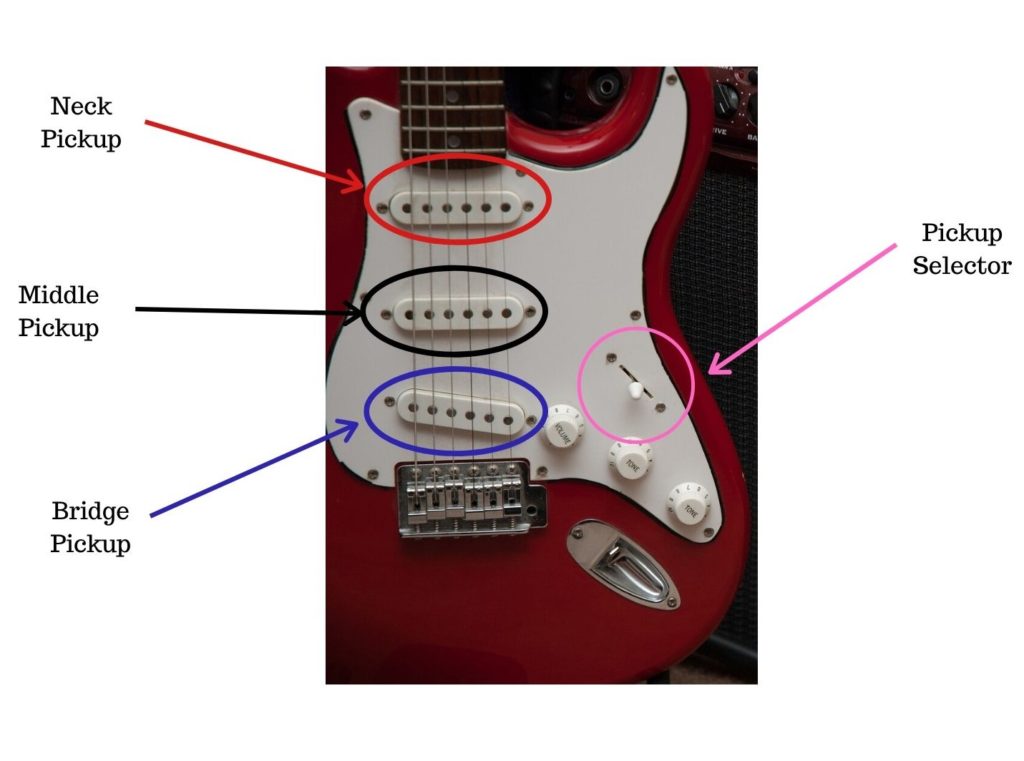
Pickup Combinations
In order to create different sounds, different guitars can use different pickup combinations and configurations. There are three really common pickup configurations categories: single coil only, humbucker only, and mixed (single coil, humbucker, P90).
Before we jump into the most popular pickup configurations and how they sound, here’s a quick guide to the terminology.
- S – refers to a single coil pickup
- H – refers to a humbucker pickup
- The order of the letters goes from the bridge to the neck. For example, an S-H configuration has a single coil pickup in the bridge position, and a humbucker pickup in the neck position.
Single pickup type Configurations
So, we will start with the most simple pickup configurations, the ones that only use one type of pickup. These can either be just single coils, humbuckers or P90s. The only variable to really think about here, is the number of pickups.
Usually, you will see the following configurations:
- S-S
- S-S-S
- H-H
- H-H-H
Having a three pickup configuration gives you more versatility. This is because you get 5 possible sounds.
- Bridge pickup only
- Bridge and middle pickup in combination
- Middle pickup
- Middle and neck pickup in combination
- Neck pickup only
With a two pickup configuration, you only get 3 possible sounds.
- Bridge pickup only
- Bridge and neck pickup in combination
- Neck pickup only
Mixed Pickup Type Configurations
To give you even more versatility, you can choose a mixed pickup configuration. This allows you to have the different sounds of each pickup type on the same guitar. You can get these combinations in a two pickup configuration (e.g. H-S or S-H), or three pickup configurations (e.g. H-S-S or H-S-H).
This is a pretty big topic so I’ve written an entire post to explain what each different combination sounds like. Head over to my post on the best pickup configurations to learn more.
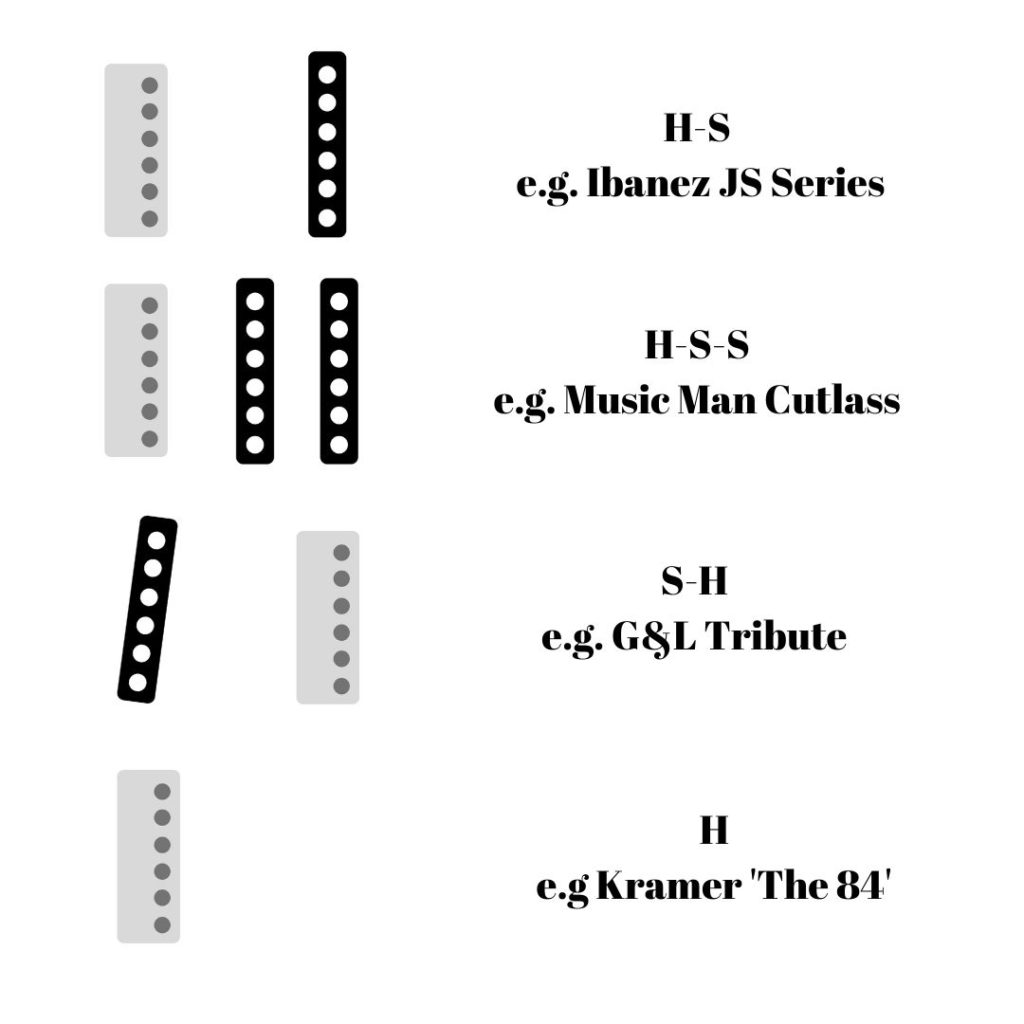
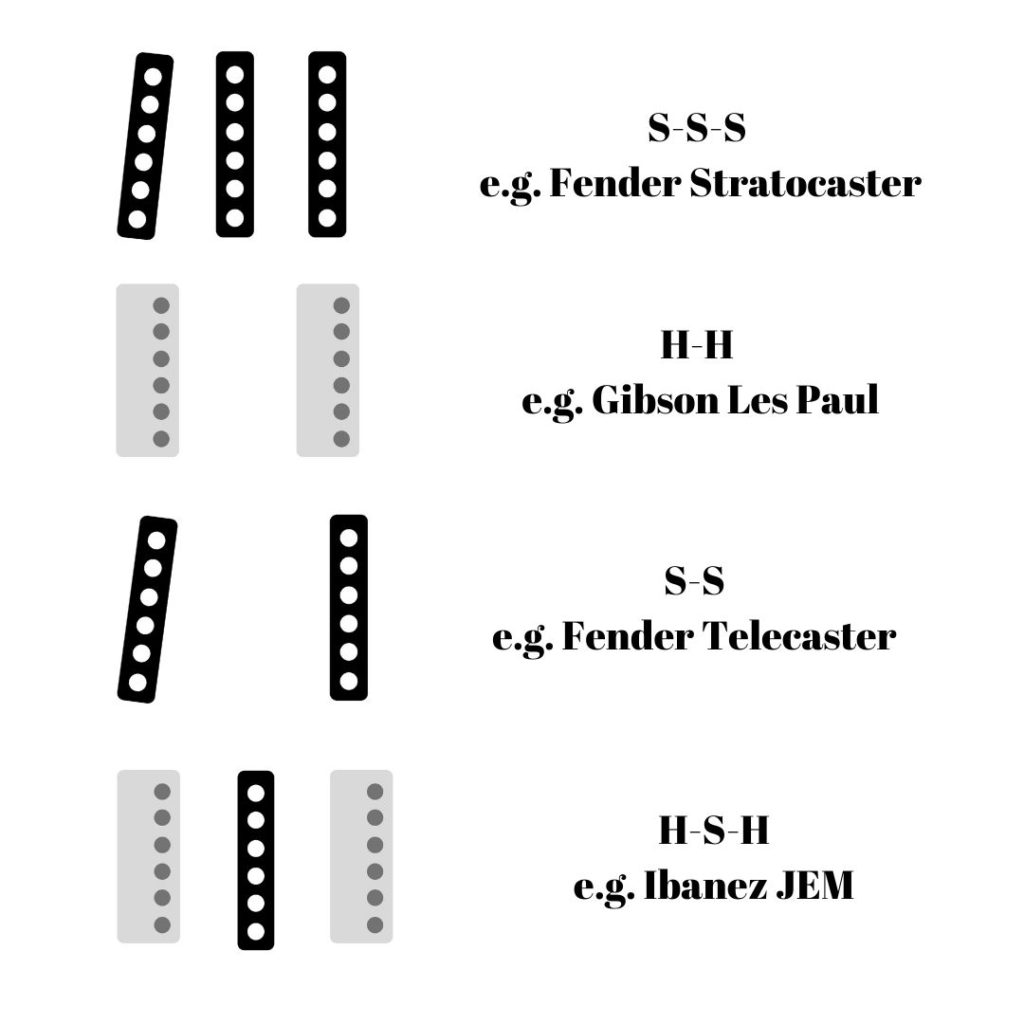
Coil Splitting and Tapping
Another thing to think about when talking about guitar pickups, is coil splitting and tapping. These two terms are often confused with each other, but they are actually different things. We’ll start with coil splitting.
Coil Splitting
Essentially, coil splitting is used to make a humbucker pickup sound like a single coil.
Coil splitting works by taking one of the humbuckers two coils, and shutting it off. It’s the push-pull action of the tone knob which connects and disconnects the circuit when in the down or up position to allow one coil to be active, or both coils.
You can “split” the humbuckers to create the single coil sound, usually really simply. On a lot of guitars you just pull the tone control up and it will lift into a new position. In the “up” position, you’ll get the coil-split effect which will only activate one coil to sound like you’re using single coils. In the “down” position, you’ll get the humbucker sound.
Coil Tapping
Coil tapping refers to the action of deactivating one coil of a humbucker pickup, so it’s a bit more complicated than coil splitting, although it does give you a similar effect in that it gives a humbucker the ability to sound like a single coil as well.
Coil-tapping involves routing a wire around half way through the number of winds and at the end of all the winds of wire. For example, you could route the pickup at 500 coils and at a 1000 coils, if the pickup is intended to have 1000 coils in total.
The result is that you can produce two different tones. One at the half-way mark of the number of coils, and one at the original number of coils.
What’s the Advantage of Coil Splitting or Tapping?
Well, the advantage of using pickups with these features, is that it allows you to have the tone of a single coil type pickup, and a traditional humbucker in one guitar. If you want versatility, then this is a great option to go for.
Which Guitars Use Coil Splitting or Tapping?
PRS manufacture guitars that offer a coil split function, for example, the guitar I own the PRS SE Custom 24 does this. Jackson and Chapman guitars also offer coil splitting on some models.
The best way to check when you’re trying a guitar out, if it has coil split or tapped humbuckers, is by gently pulling the tone control upwards. If it has this feature, it’ll easily click into place, so don’t try and force it.
Are There Any Disadvantages?
The main disadvantage of coil splitting and tapping, is that you still get the humming sound when you crank up the gain as you would with single coil pickups.
Also, in the split/ tapped position, the sound of the pickup will be weaker. Coil split or tapped humbuckers don’t usually sound as great as single coil pickups in this position so don’t expect it to sound like a true single coil pickup.
Coil split position (left) and standard humbucker position (right)
Best Pickup Brands
Now we’ve been through all the different types of pickups, I though it’d be a good idea to take a look at some of the most well-known brands out there. Of course there are loads of different brands that make pickups but these four are probably the most well-known:
- Seymour Duncan
- DiMarzio
- EMG
- Bare Knuckle
Seymour Duncan
Seymour Duncan are a hugely well established pickup brand that produce a wide variety of different pickup types. They’re an American based brand that have been around for decades. Some of their most popular pickups include the: Antiquity Humbucker and the Vintage Blues ’59.
DiMarzio
DiMarzio are another American brand and are well know for producing high powered pickups that produce a punchy sound. They’re popular with rock and metal guitarists and have been used by the guitar legend Steve Vai. Some of the most popular DiMarzio pickup models include the Super Distortion S and the DP149.
EMG
This is another American brand that have dominated the metal world. EMG are well know for producing super high output pickups like active humbuckers. However they also produce a range of other pickup types. Some of the most well-known models include the EMG-85 Active Humbucker and the EMG Metal Works.
Bare Knuckle
This is an English brand that have gained a lot of popularity over the past decade. They make both single coil and humbucker pickups that are super loud.
Frequently Asked Questions
So to round off this article, here are some of the most frequently asked questions about guitar pickups that you may still have.
what are the best pickups for metal?
Generally, the best pickups for metal are active humbuckers. These give you a lot of output, but still plenty of clarity which essential for hearing note separation when using a lot of gain.
what are the best pickups for blues?
For blues, you can get away with any of the main types: single coil, P90 or humbuckers. Having a mixture of different pickup types in a three pickup configuration will give you the most versatility. For example a H-S-S configuration will give you a lot of power in the bridge, but the single coils will give you that added brightness.
what are the best pickups for rock?
If you’re looking for a heavier darker rock tone, then your best bet is humbucker pickups. Passive humbuckers will give you a full and warm sound, that doesn’t sound as artificial as active pickups.
If you’re looking for something a bit brighter and you’re using less gain, then either P90’s or single coils will do the trick. A H-S-S or H-S-H configuration is great for rock music because it gives you tonnes of versatility.
what are the best pickups for country?
For country music, you will usually be best off with single coil pickups. These will give you a crisp and clear tone that really suits clean amp settings. You may find that humbuckers are a bit to dark and mellow for twangy country style music. But if you need something with a bit more power, then you can try a P90 to get a cross between a humbucker and single coil sound.
which pickups should i get?
Unfortunately, this is a pretty impossible question to answer without knowing the following things:
- What kind of tone do you like?
- Which styles of music do you play?
Your best bet is to go to a guitar store and try a guitar with each pickup type, and also some different pickup configurations. Try them back to back and using clean, overdriven and distorted amp settings. This will give you the best idea of what kind of pickups will be best for you.
So there you go! That’s the ultimate guide to electric guitar pickups! I hope you’ve found this article helpful, thanks for reading. Here are some other posts you might find useful:
